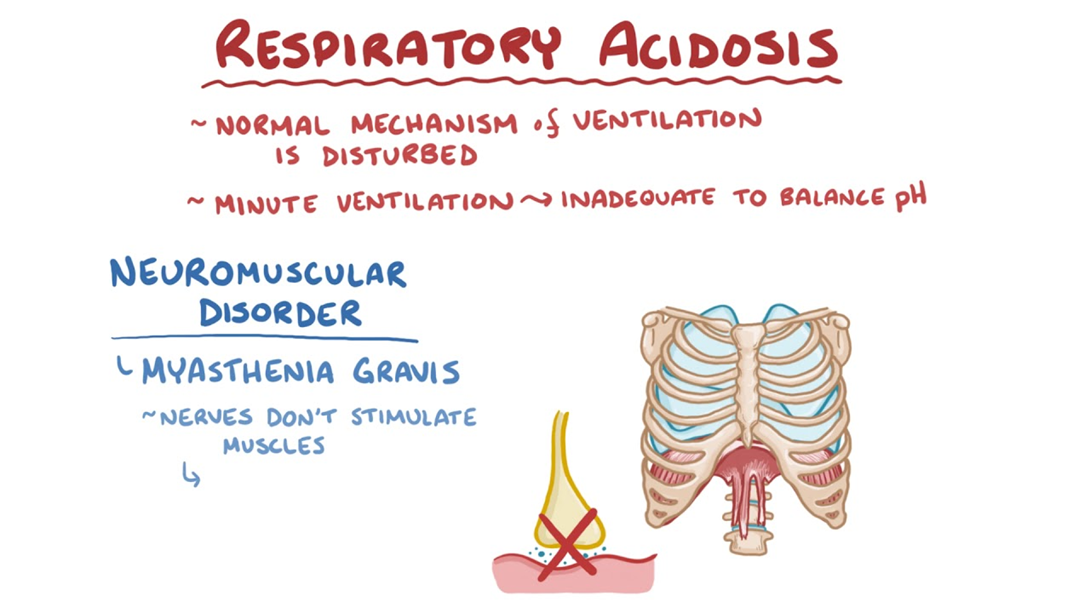A nurse is reviewing the ABG values of a client who has pneumonia. Which of the following findings indicates the client is developing respiratory acidosis?
PaO2 85 mmHg
pH 7.47
HCO3 25 mEq/L
PaCO2 55 mmHg
The Correct Answer is D
Choice A reason: PaO2 85 mmHg is within the normal range of 80 to 100 mmHg and does not indicate any hypoxemia or oxygen deficiency.
Choice B reason: pH 7.47 is within the normal range of 7.35 to 7.45 and does not indicate any acid-base imbalance.
Choice C reason: HCO3 25 mEq/L is within the normal range of 22 to 26 mEq/L and does not indicate any metabolic disturbance.
Choice D reason: PaCO2 55 mmHg is above the normal range of 35 to 45 mmHg and indicates respiratory acidosis, which is a condition where the lungs cannot eliminate enough carbon dioxide and the blood becomes too acidic. This can be caused by pneumonia, which can impair gas exchange and ventilation.

Nursing Test Bank
Naxlex Comprehensive Predictor Exams
Related Questions
Correct Answer is B
Explanation
Choice A reason: The thigh-high stockings should reach just below the gluteal folds, not above them. If the stockings are too high, they can cause constriction and impair circulation.
Choice B reason: Reapplying the stockings before getting out of bed is an appropriate action. The client should remove the stockings at night and inspect the skin for any signs of irritation or breakdown. The client should also elevate the legs for 15 minutes before putting on the stockings to reduce edema and improve venous return.
Choice C reason: Flexing the toes when applying the stockings is not an appropriate action. The client should point the toes and foot downward when applying the stockings to prevent wrinkles or folds that can cause pressure ulcers.
Choice D reason: Rolling down knee-high stockings slightly to provide comfort is not an appropriate action. The client should avoid rolling or folding the stockings as this can create a tourniquet effect and impair blood flow.
Correct Answer is D
Explanation
Choice A reason: Ammonia 55 mg/dL is within the normal range of 15 to 60 mg/dL and does not indicate any liver dysfunction or bleeding risk.
Choice B reason: Bilirubin 1.0 mg/dL is within the normal range of 0.3 to 1.2 mg/dL and does not indicate any liver damage or jaundice.
Choice C reason: Aspartate aminotransferase 34 units/L is within the normal range of 10 to 40 units/L and does not indicate any liver inflammation or injury.
Choice D reason: Platelets 60,000/mm³ is below the normal range of 150,000 to 450,000/mm³ and indicates thrombocytopenia, which is a low platelet count that can increase the risk of bleeding during or after the liver biopsy. The nurse should report this value to the provider and monitor the client for signs of bleeding, such as bruising, petechiae, hematuria, or melena.
Whether you are a student looking to ace your exams or a practicing nurse seeking to enhance your expertise , our nursing education contents will empower you with the confidence and competence to make a difference in the lives of patients and become a respected leader in the healthcare field.
Visit Naxlex, invest in your future and unlock endless possibilities with our unparalleled nursing education contents today
Report Wrong Answer on the Current Question
Do you disagree with the answer? If yes, what is your expected answer? Explain.
Kindly be descriptive with the issue you are facing.
